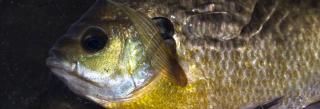
The Bluegill Spawn
Bluegill spawn late May and June when water temperatures near 22 C (71.6F). Large territorial males build nests in aggregations called colonies. Nesting colonies are generally found in shallow water (0.4 m to 1.4 m deep).
Males make disk shaped nests using their tail fins. Nests typically range in size from 20 cm to 45 cm in diameter.
Males aggressively defend their nests from other males and would be predators. Defense includes biting, chasing, and even making sounds with their pharyngeal teeth.
When a female chooses a particular male and his nest, a courtship initiates. In this courtship, the male and female bluegill will circle each other during which time, the female will make a series of ‘dips’. During her dips, the female will release 10 to 30 eggs which the resident male will fertilize. Several hundred dips can occur during a single courtship which can last for hours.
It is common for a fish’s color to darken during courtship.
After spawning, territorial males will guard the nest for about ten days until the eggs hatch to swim-up fry and disperse.
Nest emptied, the male will move off to feed and regain strength before possibly repeating the spawning process again. It is common for bluegill to have multiple spawns during a season. This is evidenced by the range of sizes observed in young of the year bluegill during fall reproduction surveys.
This, however, is not the complete story. There exist other strategies that male bluegill employ to achieve fatherhood.
These strategies (collectively termed cuckoldry) include ‘sneaker’ males and ‘satellite’ males.
By comparison to large territorial males, cuckolders are smaller in size, live shorter lives, and mature at earlier ages. Sneakers tend to be quite small, often of similar size to juvenile bluegills. The sneaker male will hang around the periphery of a nesting colony and watch actively courting pairs of territorial males and females. He then times the rhythm of the courting female’s dips and, as his name implies, quickly sneaks into the nest to release his sperm as the female is dipping. Just as quickly he retreats to the periphery of the colony.
The satellite male’s strategy is to look like a female. This mimicry is accomplished through body size and coloration. The satellite male will attempt to join an actively courting couple. If the territorial male is successfully fooled into thinking he will have two mates instead of one, the former courting pair will become a trio. The satellite male will position himself between the territorial male and the female. During the female’s dips, both males will attempt to fertilize her eggs.
To further complicate matters, sometimes a sneaker male will evolve into a satellite male. Also, some lakes have cuckoldry in their bluegill populations while others do not. It is proposed that presence, absence, and extent of cuckoldry is a factor of both genetics and environment.
(The majority of this information was summarized from: Spotte, S. 2007. Bluegills: biology and behavior. Pg 87-115. American Fisheries Society, Bethesda, Maryland.)
